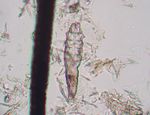|
|
| (42 intermediate revisions by 5 users not shown) |
| Line 1: |
Line 1: |
| − | {{OpenPagesTop}}
| + | [[Image:Demodex canis.jpg|right|thumb|150px|''Demodex canis'' - Wikimedia Commons]] |
| − | {{Taxobox
| + | *''Demodex spp.'' found on all domestic mammals and in humans |
| − | |name =''Demodex spp.''
| + | **Each host has its own species |
| − | |kingdom =Animalia
| |
| − | |sub-kingdom =
| |
| − | |phylum =[[:Category:Arthropods|Arthropoda]]
| |
| − | |super-class =
| |
| − | |class =[[:Category:Arachnida|Arachnida]]
| |
| − | |sub-class =Acari
| |
| − | |super-order =Acariformes
| |
| − | |order =
| |
| − | |sub-order =Prostigmata
| |
| − | |super-family =Cheyletoidea
| |
| − | |family =Demodecidae
| |
| − | |sub-family =
| |
| − | |genus =Demodex
| |
| − | |species =''D. canis'', ''D. aurati'', ''D. criceti'', ''D. bovis''
| |
| − | }}
| |
| − | ==Introduction==
| |
| − | [[Image:Demodex canis.jpg|right|thumb|150px|''Demodex canis'' - Joel Mills, Wikimedia Commons]] | |
| − | ''Demodex spp.'' are found on all domestic mammals as well as in humans and are usually a commensal organism. It is a [[Burrowing Mites|burrowing mite]] as opposed to a [[:Category:Non-Burrowing Mites|surface mite]] meaning that it penetrates into the host's tissue. Each host has a specific species of the ''Demodex'' mite. A clinical infection of ''Demodex spp.'' is termed [[demodicosis]]. | |
| | | | |
| − | ==Identification==
| + | *Causes <big>'''[[Demodicosis]]'''</big> |
| − | The ''Demodex'' species have a distinctive cigar shaped appearance under microscopic examination. Adults and nymphs have four pairs of stumpy legs on the anterior portion of the body, compared to larvae which only possess three pairs of legs. These species are Prostigmata, with their breathing apparatus on the anterior portion of their bodies. Prostigmata is a suborder of the class Acari containing mites with anterior breathing apparatus. This distinctive long and narrow appearance allows them to burrow into and remain inside hair follicles. The eggs are also laid into the hair follicles and look relatively long and spindle shaped.
| |
| | | | |
| − | ==Detection== | + | ==Recognition== |
| − | Detecting ''Demodex'' species on animals requires the use of either a deep skin scrape or a hair pluck. These samples can then be prepared in liquid paraffin and analysed under a microscope. Adult mites, larvae and eggs may be demonstrable. Detection of a single mite is not diagnostic as they are common commensals, instead the observation of concurrent clinical signs should be used to diagnose [[Demodicosis|demodicosis]].
| + | *Cigar shaped |
| | | | |
| − | ==Life cycle==
| + | *Four pairs of stumpy legs on the anterior end |
| − | ''Demodex'' species complete their <u>entire life cycle within the hair follicles and sebaceous glands of a single host</u>. Their life cycle takes 3 weeks to complete. The female lays 20-24 '''eggs''' at a time into hair follicles. '''Larvae''' are hexapod and are the same in appearance as the adult mites during their 3 larval stages.
| |
| | | | |
| − | Transmission between hosts occurs by close contact. Usually these mites will be commensals of the host from a young age due to maternal transfer to the neonate during suckling.
| + | *Long and narrow to fit into hair follicles |
| | | | |
| − | ==Important Species==
| |
| − | ''Demodex canis''
| |
| − | ::This is by far the most commonly seen species of ''Demodex'' causing clinical problems. Its host species is the dog and [[demodicosis]] is usually a secondary opportunistic pathogen due to other underlying conditions.
| |
| | | | |
| − | ''Demodex criceti'' & ''Demodex aurati''
| + | ==Life cycle== |
| − | ::Cause [[Mites - Hamsters#Demodicosis|hairloss in hamsters]].
| + | *Live as commensal organisms |
| − | | |
| − | ''Demodex bovis''
| |
| − | ::Causes pea shaped nodules in cattle.
| |
| − | | |
| − | ''Demodex merioni''
| |
| − | ::Causes [[Mites - Gerbils#Demodecosis|hairloss in gerbils]].
| |
| − | | |
| − | {{Learning
| |
| − | |flashcards = [[Mites_Flashcards|Mites Flashcards]]<br>[[Cytology Q&A 18]]
| |
| − | |literature search = [http://www.cabdirect.org/search.html?q=title%3A%28Demodex%29&fq=subject_facet%3A%22Demodex%22 ''Demodex'' publications]
| |
| − | |Vetstream = [https://www.vetstream.com/canis/search?s=mite Mites]
| |
| − | }}
| |
| − | | |
| − | ==References== | |
| − | Forsythe, P (2007) '''Collection and interpretation of clinical samples for dermatological analysis''' ''In Practice 2007 29: 158-16''
| |
| | | | |
| − | Henfrey, J I (1990) '''Canine Demodecosis''' ''In Practice 1990 12: 187-19''
| + | *Live in hair follicles and in sebaceous glands |
| | | | |
| | + | *Life cycle takes '''3 weeks''' |
| | | | |
| − | {{review}}
| |
| | | | |
| − | {{OpenPages}}
| |
| | | | |
| − | [[Category:Burrowing_Mites]] | + | [[Category:Demodicosis]] |
| − | [[Category:Expert_Review]]
| |
